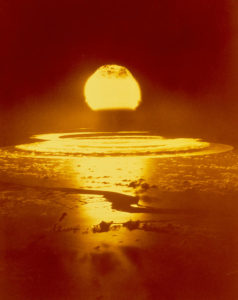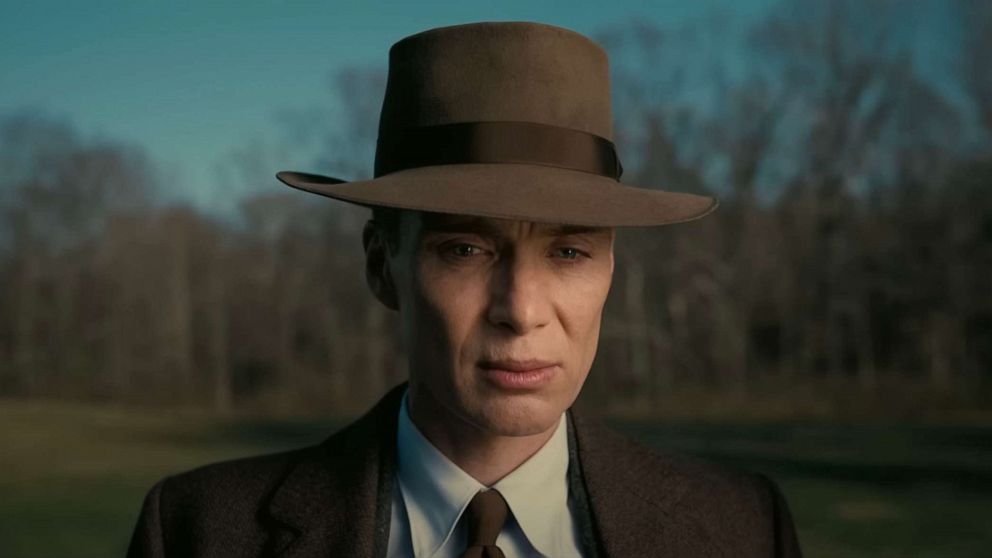#29 OPPENHEIMER MEETS THE BUDDHA IN REDFACE

Cillian Murphy as J. Robert Oppenheimer
In 1981, my first year at Naropa, Ram Dass came and did some talks. One thing he said has always stuck with me: “People ask me what I think about the theory of reincarnation, and they get mad when I tell them it’s not a theory, it’s a fact.”
It’s not a theory, it’s a fact. While I’d never considered it until recently, that would apply to the atomic bomb, wouldn’t it?
What got me to thinking about this was a book Melissa Moore gave me called Buddha in Redface by Eduardo Duran (2000). Duran, a Native American who took the academic route to a psychology Ph.D. and a therapist job, starts working in New Mexico, in an area his grandfather once farmed until forced off his land by…the American government, who put the Los Alamos atomic bomb lab on it.
More precisely, it was J. Robert Oppenheimer who chose to put it there, the subject of this year’s big splash flick, Oppenheimer. But I’m getting ahead of myself.
Duran, trained in cognitive behavioral therapy and the scientific view, immediately runs into problems trying to treat Native Americans as they simply don’t respond to it like middle-class Americans do. He’s puzzled about how to help them, and has a series of consultations with his superior, a died-in-the-wool (it seems) scientific materialist who really does (or tries to) believe that only the scientific method establishes what is real, and everything else is woo-woo bullshit. (I had quite a few moments of wanting to argue with this guy, an irritant foil through most of the book.)
Problem is, the world as Duran’s academic education describes it starts to unravel when he meets this crippled old indigenous guy with a colostomy bag living in a rundown house out on the edge of nowhere. In classic fashion, he thinks he’s going there to do therapy for a client, but meets instead someone who will do far more than therapy on him. That the who needs the help scenario gets flipped around merely begins a long sequence of things that don’t fit at all into the world as constructed by the B.F. Skinners and Richard Dawkins types.
For Duran, it’s a meet-the-lama moment, one he was in no way looking for, at least not consciously. Tarrence (the old guy) always seems to know when he’s coming, responds to his thoughts before he can say them aloud, and turns out to be surprisingly erudite, speaking often in Buddhist terms, but with a frame of reference inclusive of the western tradition. Having known myself a couple of Native American women trained in western knowledge and methods, as well as that of tribal shamanic traditions, it’s refreshing to meet people who seem genuinely in spiritual balance and capable of confronting the 21st century on its own terms.
But it’s not exactly the 21st century that Duran has to confront. He’s brought into a cave and brought into “Dreamtime,” something that doesn’t really get a definition in the book, but I’d describe it as a visionary space where he can converse with the spirits and see into the past. These parts can get pretty trippy (hey, I can roll with Jesus as a rattlesnake, but some might find that a bridge too far), though part of the point has to be that anything can manifest here. He sees one of his ancestors, a long ago shaman–who may be his ancestor or may be himself in a previous birth?—contributing with other shamans gathered to gestate a power of great vengeance in response to the Spanish genocide inflicted on Mexico.
Which brings us to Oppenheimer. It was a jolt for me, watching the movie, to see Oppenheimer (a terrific Cillian Murphy) and General Groves, head of the Manhattan Project (Matt Damon) ride in a jeep into a valley in New Mexico, deciding to put the lab there, in the same way Duran sees it taking place in one of his visions. It’s a triumph of the movie-making that it puts you right there in scene after scene, vivid, sharply crafted, like you’re living it yourself.

Murphy & Damon in Oppenheimer
You have to marvel at Oppenheimer and some of the people around him, men (usually) of enormous intellect—and rare, too, to see a movie so interested in someone being genuinely, epically smart in their book-learning. The movie makes the point that as a scientist, Oppenheimer’s a klutz in the lab, but a high voltage genius philosophically as a theoretical physicist. He even seems to be a polyglot (I guess they had a lot more time in those days). There’s a bit of Marvel’s Dr. Strange/Tony Stark arrogance to him, as well as yet again another demonstration that world class intellect doesn’t automatically prevent you from being a horny philanderer.
In other words, he’s still human, after all, but engaged in trying to end a world war and a genocide (Oppenheimer’s Jewish). Here’s where the immediate karma starts to press in. They believe they’re in a race with Hitler to achieve the ultimate weapon. They see (accurately) that Hitler would have no compunctions about using it, though the Allies march into Berlin before the Germans can invent it or they can use it on the Germans. Nevertheless, Japan remains, and on their best understanding, won’t surrender. When the bomb does get used, destroying two entire cities, it stops the war and likely avoids far more casualties than a land invasion—sacrificing 110,000 people in all, mostly civilians. Oppenheimer’s no sociopath. He feels what that means, and we feel it with him.
It’s interesting that while others do the practical work, his bomb comes from theory. He (following Einstein) theorizes massive devastation into existence. We live out with him both the dazzling possibilities of applied intellect (not to mention the American can-do spirit), the desperate need to end war, and the deeply felt, existential ambivalence of what he’s brought into being—something, in fact, we all continue to live with.
It’s precisely the karmic roots of this action and its result that Tarrence guides Duran into shamanically unearthing. Duran, Tarrence, and others around Tarrence can trace back their previous lives to envisioning and gestating this weapon, incubating it in their grief and vengeance, though it did not come to fruition until the XXth century. Isn’t that how karma is supposed to work? The developed force of intention has its own inertia, and strong enough intention, pure and compassionate or driven by power and rage, sooner or later finds its karmic coordinates and plays itself out.
Tarrence makes a point that the old shamans, while highly developed in magical power, tended to get distorted notions of that power. They weren’t, in Buddhist terms, functioning in accordance with selfless compassion but subject to their kleshas (Sanskrit: “afflictive emotions”). In one of many philosophically fascinating exchanges in the book, Tarrence connects this to the role of scientists today:
Why do you think they’re still continuing the sorcery they call science? The science they do here is a direct descendant of alchemy, and alchemy was a deep spiritual practice, the practice of finding the philosopher’s stone, which was God or [intrinsic] awareness itself. Once alchemy was discarded as just voodoo and science replaced it…well, that was the beginning of sorrows….Science defined itself as the [intrinsic] awareness [,the true wisdom,] and the only way to the awareness. Everything else would become heresy unless subjected to the validation of the high priests of the new religion—science.
Later on he says, “Once the church wasn’t able to control the masses, then science was invented. Practitioners of science are priests of the new order—and sorcerers. Of course most of them have no idea what they really are doing. It remains unconscious, and this is where it becomes ignorance.”
Did Oppenheimer, as intensely brilliant as he was, know what he was doing? It’s that funny thing, isn’t it, in human life, where you think you do, but when you look back, maybe you didn’t realize where it was all heading or even what motivated your actions to begin with.
You may not buy any of this, and explain it away in one way or another. Duran, however, must enter vision and take the shaman’s journey to recover the potent, dangerous, energetic ore of karma and diffuse it, seeking to heal a deep and unbearable wound from the past, but this is how shamanic healing is done.
It’s safe to say that Oppenheimer never healed the wound he opened in himself. When asked about what to do with that land in New Mexico in the movie, he says contritely, and I think with genuine sincerity, to give it back to the Indians—it’s their land to begin with. He fails to mark that it’s now soaked in radiation. That’s the complicated bequeathment left us by his generation and the many that led up to it.



Coherent & chilling @ times marriage btwn book & film. Want to read The Buddha in Red Face now too. Reminded me of your Rhonda, is she in state at all anytime soon?
Wonderful essay! It is a very clear description of the usurpation of the sacred and the power of the sacred that scientific materialism has achieved, and of the power of karma. Just great!
Kurt Vonnegut: ““The truth is, we know so little about life, we don’t really know what the good news is and what the bad news is.”
Alan Watts: “The whole process of nature is an integrated process of immense complexity, and it’s really impossible to tell whether anything that happens in it is good or bad — because you never know what will be the consequence of the misfortune; or, you never know what will be the consequences of good fortune.”
We never know outcomes, we can only know our motivations, and given that over 98% of mental activity is unconscious, I’m not even sure we can really know those either.
Technology is our new religion; the technologists (a label once applied to yours truly) are dealing the cards we all get to play. There is hope, however, as the mistake of separating the scientific method, consciousness, and morality, a mistake made by the likes of Galileo and Décartes, appears to be coming to an end, and quickly. The only question is if a new, more holistic science will emerge quickly enough for us to save ourselves. On that note, I’m not sure what I’m personally more afraid of – AI getting way better, or AI never getting better enough to save our butts from the mistake of relying on extreme intelligence devoid of wisdom.
“Holistic science.” Well, there’s an idea. I feel like I’ve been on the side of trying to point out that science doesn’t know everything, and operates from a too limited sense of what is valuable in the mind, ie, just intellect. Intellect can produce an atomic bomb, but what created the context that an atomic bomb could be brought into existence by intellect, and beyond that, don’t we a need a kind of knowledge that can foresee the outcome of bringing it into existence?